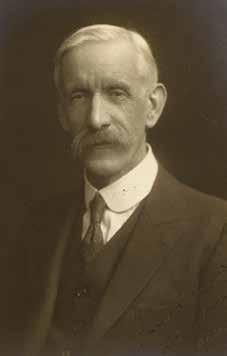
2 minute read
Sir Frederick Gowland Hopkins

The Society was thrilled to receive a portrait of Sir Frederick Gowland Hopkins (as seen on the front cover) in March of this year, a gift from MRC Elsie Widdowson Laboratory after its closure. As one of the founders of the Nutrition Society, Sir Frederick’s achievements are commemorated with the Gowland Hopkins award which honours senior scientists working within the area of Cellular and Molecular Nutrition. 2019 will be the first time the Gowland-Hopkins has been awarded, with the inaugural ceremony planned for the Annual Charity Meeting on 9 September 2019. But, what do we know about the life and work of the man himself?
Advertisement
Sir Frederick’s vital research over the years shone a light on the ‘accessory food factors’, later named vitamins, which had an enormous impact on growth and function in living things, despite being present in tiny amounts in the diet.
He was born in Eastbourne in 1861 where he was raised by his mother and uncle; his bookseller father having died when Sir Frederick was a baby. Ten years later, the family moved to Enfield in North London, where he excelled in science, particularly chemistry.
The first big break came in 1883, when Sir Frederick was offered a post at the Home Office to work on poisons alongside Sir Thomas Stevenson. This led him to complete a BSc in chemistry followed by a medical degree at Guy’s Hospital, London. After graduating, he continued at Guy’s teaching physiology and toxicology, during which time he developed research into what would become the new discipline of biochemistry. His early experiments revealed the workings of lactic acid and muscle contraction, before Sir Frederick’s attention switched to nutrition.
A move to Cambridge University in 1898 began a period of intense research, culminating in the work that made his name. Sir Frederick’s first success was to isolate the amino acid, tryptophan, from protein and prove that certain amino acids could not be manufactured by the body. This led to the concept of ‘essential’ amino acids. Further research on laboratory animals revealed that the prevalent view of a balanced diet – one that contained sufficient proteins, fats, carbohydrates, minerals and water – was lacking something vital. His papers in 1906 and 1912 are acknowledged as the first to develop the theory on the importance of vitamins.
Subsequently building on research by Christiaan Eijkman, Sir Frederick discovered that thiamin in unprocessed rice could reverse the deficiency disease beriberi. For this work, he and Eijkman were awarded the 1929 Nobel Prize. Honours rapidly followed: the Royal Medal of the Royal Society of London in 1918; a knighthood in 1925; and the Order of Merit in 1935. Until his death, Sir Frederick continued to influence his peers and oversaw the flourishing of the two disciplines that he had nurtured during his lifetime.
The Nutrition Society Annual Charity Meeting (ACM) and presentation of the Gowland Hopkins award
All members of are invited to attend the Annual Charity Meeting (ACM) on 9 September at the Royal College of Nursing, London, from 16:30.
Following the ACM, members and non-members are invited to attend the presentation of the senior Gowland Hopkins Award, and hear the award-winning research presented by the award winner.
Following the presentation of the award, all are welcome to attend the drinks reception to network with other members, Trustees and Advisory Council members.
Registration is free. Please visit the events page on the Society website.
Extract adapted from 30-Second Nutrition, Edited by Julie Lovegrove and written by Carrie Ruxton. Published by Ivy Press.





